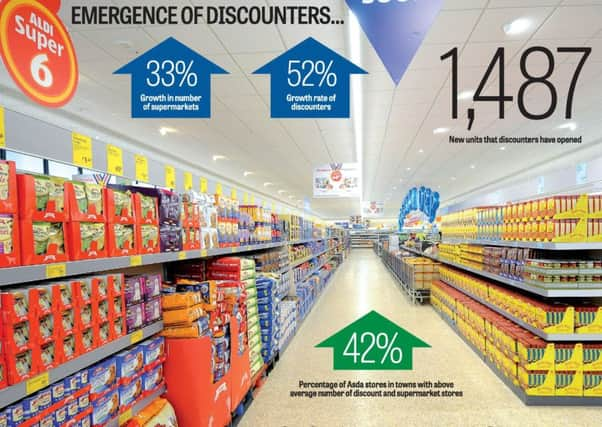Discount stores dwarfing big four openings


The overall growth rate since 2010 for the traditional big four of Tesco, Asda, Sainsbury’s and Morrisons has been 33 per cent, as compared with 52 per cent for the likes of Aldi and Lidl.
The report, published today by The Big Data Company, underscores the challenges the established supermarkets have faced in the last five years as discount chains continue to eat into their market share at the expense of their profits.
Advertisement
Hide AdAdvertisement
Hide AdIn total discounters opened 1,487 units during the five year period whereas the big four opened 570.
During 2015 alone, discount store growth was three times as fast as the big four, with each discount store growing on average by 34 units as compared to 10 units on average for the mainstream retailers.
The Big Data Company study showed Asda as having the largest percentage of their stores in towns with above average number of discount and supermarket stores, while Sainsbury’s had the fewest.
Interestingly Yorkshire was also shown to have some of the highest competition levels among grocers in the UK although, not as intense as other Northern areas or Wales.
The report excluded data from convenience stores.
Advertisement
Hide AdAdvertisement
Hide AdDr Clive Black, head of research for Shore Capital Markets said the discount chains were capitalising on the turmoil within the big four as they wrestle to restructure their businesses.
“Key findings in the recent work on supermarkets provide good insights into what is happening on the ground, where limited assortment discounters (LADs) are now opening new space at a much faster rate than supermarket groups, many of the latter engaging in recovery and focus strategies that require a cut in capital expenditure to protect their balance sheets,” he said.
“Against a back drop of sustainably poor same store trade we note with interest that Asda has the most stores in its portfolio in Britain’s fastest growing towns on LDC’s measure, whilst Tesco has the fewest, perhaps reflecting the relative maturity, size and nature of each groups’ estates.
“We expect the trends outlined by LDC to persist for some time as the discounters press on and the larger supermarket groups continue to make more from their residual estates.”
Advertisement
Hide AdAdvertisement
Hide AdMatthew Hopkinson, Director at The Local Data Company said: “This analysis of the rise and increasingly fall of the supermarkets and discounters over the last five years clearly illustrates the fierce competition and the resulting decline in sales that the big four supermarkets have experienced.
“The result has been not only the closure of supermarkets but most recently some discounters have also closed some stores of which Poundstrecher is an example.
“Supermarkets are addressing their space and offer issues with some vigour and a degree of success, and as these plans come to fruition it will be interesting to see how the discounters are impacted and react.”